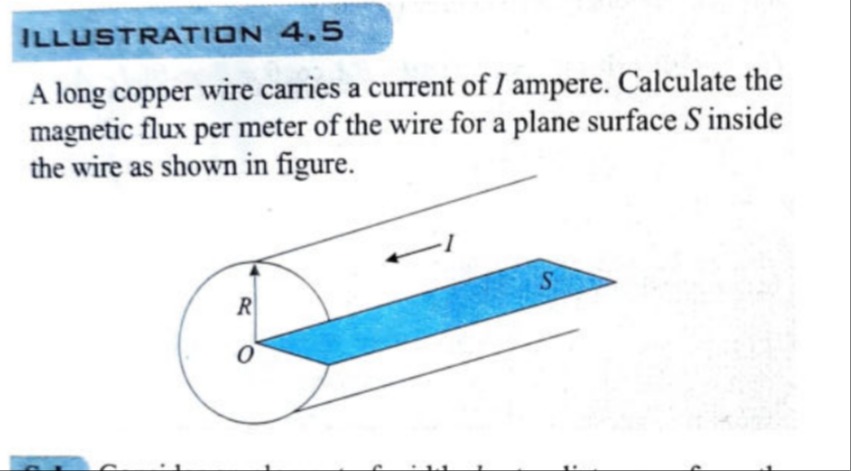Question
Question: A long copper wire carries a current of $I$ ampere. Calculate the magnetic flux per meter of the wir...
A long copper wire carries a current of I ampere. Calculate the magnetic flux per meter of the wire for a plane surface S inside the wire as shown in figure.

The magnetic flux per meter of the wire for the plane surface S is 6πμ0IRΔϕ, where Δϕ is the angle of the sector in radians.
Solution
-
Magnetic Field Inside the Wire: Using Ampere's Law, the magnetic field at a radial distance r from the center of a long wire of radius R carrying current I is given by B(r)=2πR2μ0Ir for r<R. The magnetic field lines are circles concentric with the wire's axis.
-
Surface Geometry: The surface S is a planar sector originating from the center O and extending to the radius R. Let the angle subtended by the sector at the center be Δϕ. The question asks for the magnetic flux per meter of the wire, so we consider a length L=1 meter along the wire. Thus, the surface S is a planar sector with radial extent 0 to R and angle Δϕ, and length L=1 along the wire.
-
Flux Calculation: The magnetic flux through the surface S for a length L=1 meter is given by: Φ=∫SB⋅dA The magnetic field B at a distance r is tangential to the circle of radius r. For a planar sector surface S, the magnetic field lines are circulating. To calculate the flux, we consider the component of the magnetic field perpendicular to the surface. Let's consider a small area element dA on the surface S at a radial distance r. The magnetic field at r is B(r)=2πR2μ0Ir. The flux per meter of wire is given by: LΦ=∫0R∫0ΔϕB(r)⋅rdrdθ This integral represents the flux through a surface where the magnetic field is perpendicular to the area element. Given the tangential nature of the magnetic field and the planar nature of the surface S, we need to consider the component of B that contributes to the flux. The correct approach is to consider the flux through the planar sector. The magnetic field lines are circulating. For a planar sector, the flux is obtained by integrating the magnetic field component that is perpendicular to the plane of the sector. If the surface S is a planar sector, the magnetic field lines are tangential to the circles. The flux is calculated by considering the magnetic field's contribution across the area. The flux through the surface S per meter of wire is given by integrating the magnetic field component perpendicular to the surface. LΦ=∫0R2πR2μ0Ir⋅rdr⋅Δϕ LΦ=2πR2μ0IΔϕ∫0Rr2dr LΦ=2πR2μ0IΔϕ[3r3]0R LΦ=2πR2μ0IΔϕ⋅3R3 LΦ=6πμ0IRΔϕ The magnetic flux per meter of the wire for the plane surface S is 6πμ0IRΔϕ, where Δϕ is the angle of the sector in radians.
